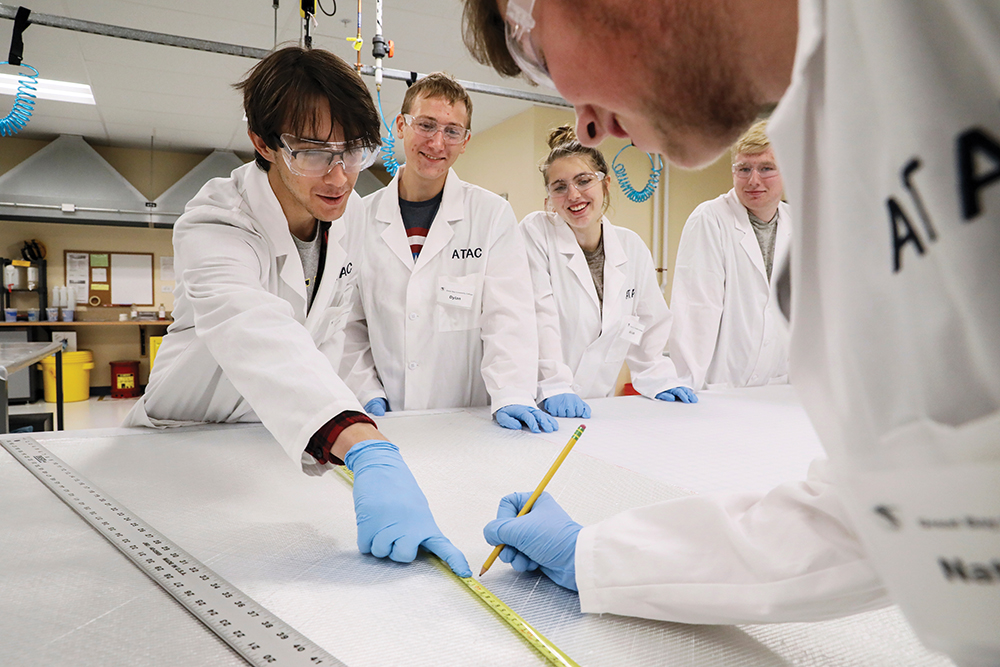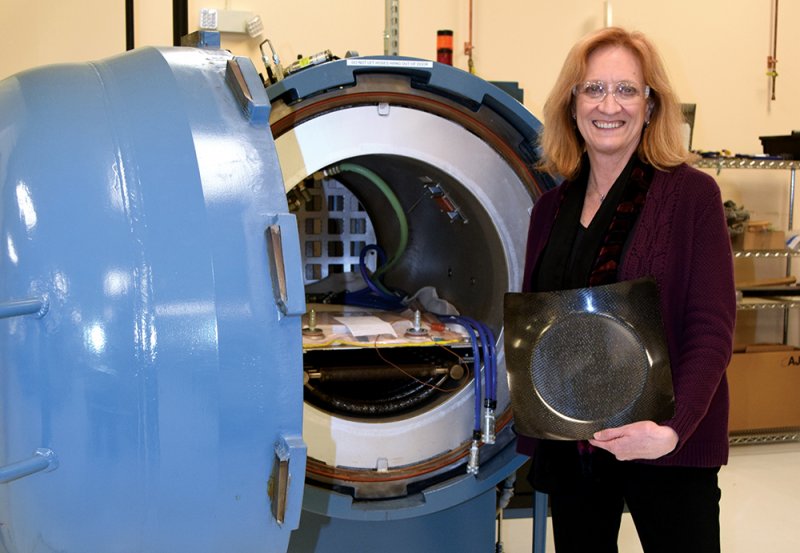
Spaulding High School students learn about manufacturing composites at the Advanced Technology and Academic Center at Great Bay Community College. Courtesy photo.
When Dean Graziano picked up a call from his wife in January, he was surprised to learn he’d received a shout-out from Gov. Chris Sununu during his inaugural speech. The governor had announced that a program Graziano launched at Rochester’s Spaulding High School will serve as the template for a new statewide Career Academy that will allow high school seniors to earn a college certificate for free.
Graziano’s program sought corporate sponsors so students could attend for free.
Impressed with the idea, NH Education Commissioner Frank Edelblut brought it to the governor with suggestions on how to make it sustainable statewide.
“Working with our community college system’s existing funds, our students can take advantage of an optional fifth year of high school that will enable them to receive a high school diploma, a certificate, and a college associate degree free of cost to the student,” Sununu said of a proposed statewide program. “It also comes with something else—a guaranteed interview with a New Hampshire company for a job right here in the Granite State.”
Graziano, the extended learning opportunities coordinator for Rochester schools, had created a program by partnering with the Advanced Technology & Academic Center (ATAC) at Great Bay Community College and Albany/Safran, an aerospace parts manufacturer, both in Rochester, that allows Spaulding High School seniors to earn an advanced composite manufacturing certificate while completing their high school diploma. Once students receive their certificate, the equivalent of 24 college credits, they are guaranteed a job interview with Albany/Safran.
Career Academy Model
Edelblut praises the Rochester program, but points out that a statewide model supported solely by donations from corporate sponsors would not be sustainable. Because the NH Department of Education and the Community College System of NH (CCS-NH) must hammer out the details, the Career Academy is at least a year away.
Under the statewide model, the Career Academy will be a public charter school embedded into the campuses of CCSNH, which will run the program. “We reached into the box of tools we had and one was the charter school,” Edelblut says.
The Career Academy will be offered at community colleges statewide for high school seniors. Any programs tied to existing curriculum will be required to have an industry partner seeking to employ graduates once they have earned their certificates.
“Since we’ve announced the program, a variety of companies have come forth and want to be an industry partner,” Edelblut says, adding that the Visiting Nurse Association is examining a possible partnership. “I am encouraged by the level of interest.”
For students enrolling directly into the Career Academy, the state will pay the $7,300 per student required to pay to charter schools. However, in order to get superintendents on board with the Academy, school districts can opt to “tuition” students to the academy. That means the student applies through their regular high school and attends the Academy but can still participate at their local high school cocurricular activities, such as athletic programs, clubs and proms.
The district retains full state adequacy and local education funding (about $16,000 per student) and covers the Academy’s $7,300 tuition.
Even if students opt to take a second year at the Academy (a “super senior” year), which lets them earn an associate degree for free, there is no additional cost to the taxpayer, Edelblut says. “It’s still the same overall cost to the state.”
Edelblut says the Career Academy will be designed not to cannibalize existing Career Technical Education (CTE) centers at high schools. As an example, he says, “No CTE centers offer a composite manufacturing program.”
However, high schoolers who complete a CTE program, such as an automotive course, and who want a more advanced program for their senior year, can enroll at the Career Academy. And those who are shut out of high school CTE programs due to limited slots can also attend.
Ross Gittell, chancellor of CCSNH, says they are already working with high school students through their Running Start Dual Credit program, which lets high school students earn college credits for college-level classes. “Many of the courses we teach are career oriented and put [students] on a career pathway,” he says. CCSNH has relationships with many industry partners, Gittell says, and the Career Academy could be a valuable workforce pipeline, especially for industries experiencing talent shortages.
Programs can also be customized to the needs of communities and even be held on-site at companies that have the equipment students need to train on, he says.
The Rochester Program
Gittell says the Rochester program indicates that the Career Academy can work.
Graziano first pitched his idea to Will Arvelo in 2016 when Arvelo was president of Great Bay Community College. The program then launched in 2018 by recruiting high school juniors in the spring to participate in their senior year.
Graziano says the aim is to expose students to local job opportunities and remove financial barriers to attending college. If students who earn advanced composite manufacturing certificates are hired by Albany/Safran. They can pursue additional education, as the company reimburses employees up to $5,250 annually for tuition costs. Or, as Graziano puts it, “You can earn and learn.”
“We need to find ways to keep kids here and have an educated workforce,” Graziano says, adding if kids find local employment, it benefits the community as they then buy homes, cars and groceries locally.
Debra Mattson, assistant director of Great Bay’s ATAC and program director of Advanced Manufacturing, says the program with Spaulding High School fits with other direct-to-career programs and provides students with the workplace and technical skills employers need.

Debra Mattson, assistant director of Great Bay Community College’s Advanced Technology and Academic Center. Photo by Matthew J. Mowry.
“Our business partners are having a hard time filling positions,” she says. “We know the curriculum is successful for preparing students to be employed.”
When Albany/Safran first came to NH, it worked closely with Great Bay to develop a program that would create a pipeline of skilled workers. The new program with Spaulding High School builds on that earlier relationship. In addition to guaranteeing a job interview to those who earn their certificate, Albany/Safran also enables some of its engineers to serve as instructors.
Sean Hoeing, human resources manager at Safran Aerospace Composites in Rochester, says the program has three main drivers: provide students with advanced manufacturing skills, provide affordable education options, and establish a culture of lifelong learning.
“There is no reason we can’t give high school students the skills they need to be immediately employable,” Hoeing says, adding that this eliminates the need to amass student debt if students are employed by the company and use its tuition program.
Mattson adds, “If we unburden students from debt, it gives them the opportunity to explore more career options.” And these high school students are expected to meet high academic standards. “They take the same courses our college students take,” she says. “They have the same rigor, homework and faculty.”
Among the Spaulding High participants is Mike Lovely, who wants to become a mechanic. He heard about the program and thought it would be “cool” to learn something new.
“It’s definitely a challenge,” he says, explaining it was more rigorous than he’d expected, though he particularly enjoys lab work and learning new technology. “It gives us a lot of opportunities,” Lovely says. “I want to use [this education]. I don’t want to waste it.”
Lovely notes that several classmates are considering careers at Safran. And the success of the pilot program is generating interest from other students and sponsors, Graziano says. When he held an information session for the 2019/2020 school year recently, 30 students and their families attended.
Lessons Learned
Both Spaulding High and state officials gleaned insights from the pilot program and say they have ideas to improve it. One lesson learned was ensuring that students are set up for success.
When the Rochester program began, 13 students enrolled. But by the second half, four had dropped out. “This is a college curriculum. They need to be able to do college-level work,” Mattson says, adding that some were unprepared for the volume of homework required.
ATAC has an academic support staff member available to help students who are struggling. Mattson says the college wants to ensure that students accepted into the program are ready for college-level courses and is now soliciting applications earlier to give them more time to test their math and reading skills. “We didn’t test them prior to the program. Next year we will,” she says.
That lesson is being incorporated into the state’s Career Academy as well, which will include “mechanisms to ensure expectations are understood, including the possible use of pre-assessments for students, as permitted,” per a draft report prepared by the state about the Career Academy. “It’s an ambitious program. We have to make sure those who enter the program have a strong likelihood of being successful,” Gittell says. “Not every high school student will be ready.”
Graziano says he wants to see more earn-and-learn programs, and Mattson says ATAC is working with Spaulding High on other plans, but adds it’s too early to disclose details. “Hopefully this fall we will have another option to offer students and maybe even a third program,” she says.
And when the state officially launches the Career Academy, Gittell says they hope to offer different tracks.
“It’s essential to have a relationship with school districts that want to participate. It’s essential to have industry partnerships. And it’s essential to keep the focus on student success and employment success,” Gittell says.
